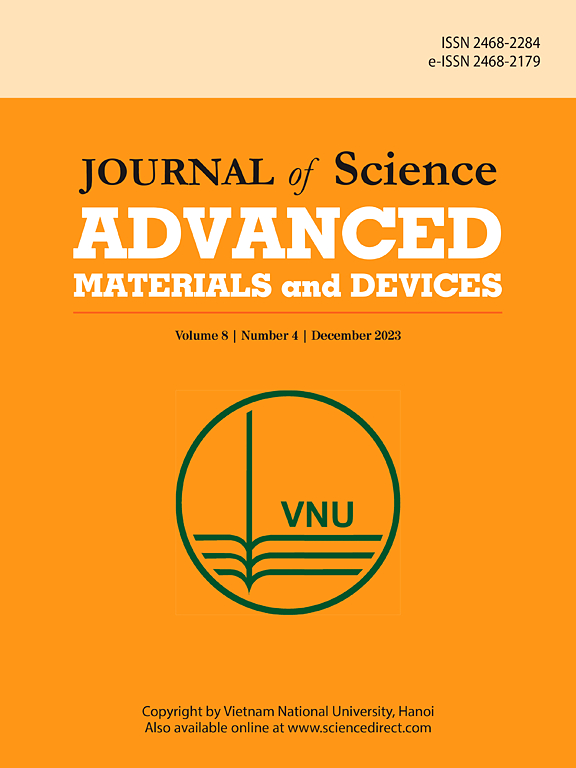Control of tungsten-epoxy composite porosity prepared using a high-energy ball milling method: An engineering aspect of backing layer fabrication
IF 6.7
3区 材料科学
Q1 MATERIALS SCIENCE, MULTIDISCIPLINARY
Journal of Science: Advanced Materials and Devices
Pub Date : 2024-09-20
DOI:10.1016/j.jsamd.2024.100793
引用次数: 0
Abstract
Tungsten-epoxy composite is commonly used as a backing layer substrate of piezoelectric-based ultrasonic transducers. The physical properties of this composite, such as porosity, play a significant role in controlling the behavior and specifications of transducer fabrication. Therefore, this study aimed to investigate the effects of tungsten content in epoxy to control porosity and determine the engineering aspects of ultrasonic transducer fabrication. The experiment was conducted using a shaker-type high-energy ball milling method, where non-spherical and faceted tungsten particles with a mean size of 1 μm were composited into epoxy resin as a matrix at various tungsten-epoxy weight ratios of 0:1 to 10:1. The prepared composite surface morphological and elemental, tungsten loading, particles, and epoxy bonding were examined and analyzed. Furthermore, analysis was carried out on the relationship between tungsten content and the parameters corresponding to the composite acoustic characteristics, such as sound velocity, acoustic attenuation, and acoustic impedance. The results showed that composite porosity increased in the range of 12.40–31.87%, corresponding to acoustic impedance from 3.04 to 9.37 Mrayl (below 10 Mrayl for biomedical ultrasonic transducers) when the tungsten-epoxy weight ratio varied from 0:1 to 10:1. This showed the significant influence of tungsten particle loading on controlling porosity of tungsten-epoxy composite by precisely tuning the weight ratio, contributing to engineering process in the fabrication. In conclusion, porosity was adjusted by controlling the tungsten loading content in epoxy.
利用高能球磨法控制钨-环氧树脂复合材料的孔隙率:背层制造的工程学方面
钨-环氧复合材料通常用作压电式超声波传感器的底层基材。这种复合材料的物理性质(如孔隙率)在控制换能器的行为和规格方面起着重要作用。因此,本研究旨在调查环氧树脂中钨含量对控制孔隙率的影响,并确定超声波换能器制造的工程方面。实验采用振动台式高能球磨法,将平均粒径为 1 μm 的非球形和刻面钨颗粒按 0:1 至 10:1 的不同钨-环氧重量比复合到环氧树脂基体中。对制备的复合材料表面形态和元素、钨负载、颗粒和环氧树脂粘合情况进行了检测和分析。此外,还分析了钨含量与复合材料声学特性参数(如声速、声衰减和声阻抗)之间的关系。结果表明,当钨-环氧重量比从 0:1 变化到 10:1 时,复合材料的孔隙率在 12.40-31.87% 的范围内增加,对应的声阻抗从 3.04 到 9.37 Mrayl(生物医学超声换能器的声阻抗低于 10 Mrayl)。这表明,通过精确调节重量比,钨颗粒负载对控制钨-环氧复合材料的孔隙率具有重要影响,有助于制造过程中的工程工艺。总之,通过控制环氧树脂中的钨含量可以调节孔隙率。
本文章由计算机程序翻译,如有差异,请以英文原文为准。
求助全文
约1分钟内获得全文
求助全文
来源期刊

Journal of Science: Advanced Materials and Devices
Materials Science-Electronic, Optical and Magnetic Materials
CiteScore
11.90
自引率
2.50%
发文量
88
审稿时长
47 days
期刊介绍:
In 1985, the Journal of Science was founded as a platform for publishing national and international research papers across various disciplines, including natural sciences, technology, social sciences, and humanities. Over the years, the journal has experienced remarkable growth in terms of quality, size, and scope. Today, it encompasses a diverse range of publications dedicated to academic research.
Considering the rapid expansion of materials science, we are pleased to introduce the Journal of Science: Advanced Materials and Devices. This new addition to our journal series offers researchers an exciting opportunity to publish their work on all aspects of materials science and technology within the esteemed Journal of Science.
With this development, we aim to revolutionize the way research in materials science is expressed and organized, further strengthening our commitment to promoting outstanding research across various scientific and technological fields.
 求助内容:
求助内容: 应助结果提醒方式:
应助结果提醒方式:


